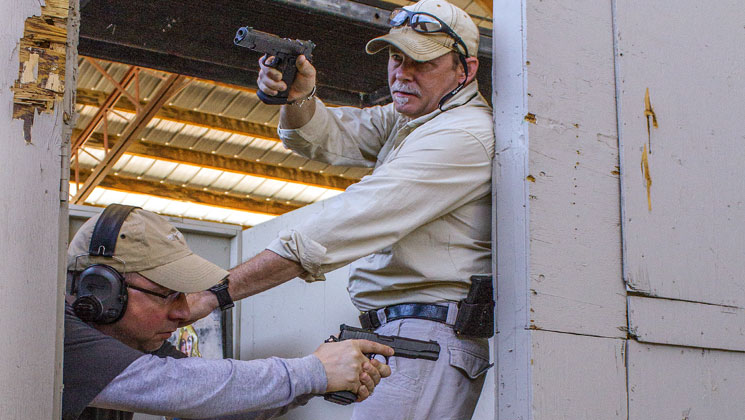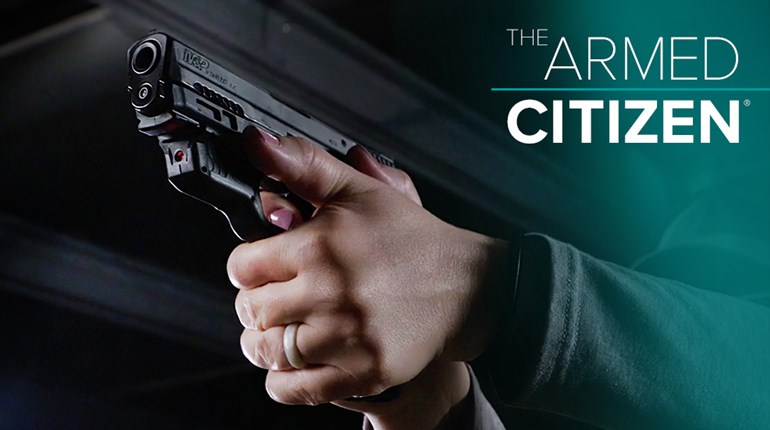
Chances are you pass dozens of corners each day. Each corner in your home represents a potential problem, because bad things can hide behind them. In a home-defense scenario, the best way to deal with a corner is to avoid it, but that’s not always possible. Clearing any corner is risky, but there are techniques to help you control the situation.
A single corner is formed by one wall joining another, usually at a 90-degree angle. It could also be the angle formed by the front of your vehicle or the edge of your refrigerator. A double corner is where a hallway enters a T-intersection, or where a door opens into a hall, the middle of a room or the outside.
Clearing a single corner is tough enough, but it is almost impossible for one person to successfully deal with a double corner. You simply cannot look in opposite directions at the same time. As you enter a double corner to clear one side, the other side is behind you. Therefore, you end up exposing your back to the unknown.
Corners are tricky, so I sought help at Gunsite Academy in Paulden, AZ. I spent a day with instructor Chris Weare, a former Marine who also served for 30 years as an Orange County, CA, deputy sheriff. Weare took me and a friend through the following basics, which will help you form a solid plan when you encounter a corner alone or with a partner.

Clearing Single Corners for Home Defense
Prior to approaching a single corner, attempt to see as much of the area beyond it as possible. Don’t focus only on the unknown space around the corner—actively clear the entire visible area. Danger could be lurking in the wide open.
When you arrive at the corner, slowly “pie” your way around the angle. Keeping your firearm at the high ready, incrementally move around the corner so the unknown area is revealed in little slices. Maintain a balanced stance; don’t lean excessively around the corner. Move only as much of your body as necessary to see the next slice of the space you need to clear, and always look before you move. Your gun should follow your eyes—keep it pointed where you are looking, so you’ll be able to immediately deliver a shot if necessary.
Don’t crowd the corner. You need space to move, and you can use distance to your advantage. The thing to remember about any corner is whatever you can’t see can’t see you either. While a corner may hide a bad guy, you can also use it to conceal your approach.
If you have a partner, he or she can cover your six—the area behind you—while you are occupied with the corner. A partner can also watch additional openings or danger areas beyond your front or to your side, such as a doorway across the room. Communicate with your partner before you begin clearing the corner, so he or she understands the roles each of you will undertake in the process.

Clearing Double Corners in the Home
To clear a double corner by yourself, pie both sides as much as possible as you approach. Upon arriving at the corner, you’ll have to choose which side to clear first. Let’s assume you want to start with the left corner. Stand in the doorway or opening with your feet pointed forward; your left foot should be about a half step ahead of your right foot. Now, move around the left corner to clear it. Immediately after establishing the left side is clear, spin on your toes 90 degrees to your right, and clear the other corner. Time is of the essence here, because your back could be exposed to a threat as you clear the left side. Work thoroughly but quickly. To clear the right corner first, reverse your footwork.
Another problem with a double corner is immediately prior to the final clear, you will be silhouetted in the doorway—the “fatal funnel.” Limit the amount of time spent in the doorway as much as possible. This applies whether you are clearing a double corner alone or with a partner.
If you have a partner, it’s much easier to clear a double corner, and it’s something you need to practice together. For example, you and your spouse might have to exit a hotel room into a hallway during some catastrophic event. Or, you could be in a local mall together and need to exit a storefront while an active shooter is terrorizing the establishment. There are a lot of double corners in the world, and you should have a plan to deal with them.
As when working a double corner alone, pie the area beyond the opening on each side during your approach. You should work one corner, and your partner should take the other. As you and your partner approach from different directions, each should concentrate on pieing his or her assigned corner. If you’re clearing the right corner, move toward the left side of the opening. Your partner, who is clearing the left corner, should approach from the right.

When you arrive at the opening, one of you should drop to a low—but mobile—position, while the other remains standing. Work this out beforehand. I have bad knees, am a foot taller than my wife and can shoot better with one hand. She’s going low, I’m going high.
Each person should get set on his or her side of the opening, continuing to cover the area beyond the assigned corner. Without breaking the inside plane of the opening, ease together until the person who is high can place his support hand on the shoulder of the partner who is low. The hand on the shoulder is key, because it allows the high partner to signal the low partner to back up if necessary as the final clearing process begins. Just the same, the person in the low position can push back with her shoulder if she sees a threat on her side, signaling to the high partner to react similarly. Remember, each person is looking in a different direction and will see things the other cannot.
Once set, you and your partner should move through the opening at the same time, hopefully clearing both corners simultaneously. If either of you needs to engage a threat, both lines of fire are clear, because one gun is low and the other is high.
After you and your partner clear the corners, both of you can move into the space around them. To maintain muzzle discipline, the low person should move in first while staying low, and the high person should move in behind while staying high. Each of you should move toward the area he or she has just cleared, taking control of the new space.
When working with a partner, strict muzzle discipline is a necessity to prevent sweeping one another. Each of you must be constantly aware of your muzzle and line of fire in relation to the other. Angles and positions are continually changing as you clear a corner, which complicates things. Practicing together is highly recommended. Use guns that have been triple-checked to ensure they are unloaded, or better yet, work with a pair of nonfiring replicas made especially for training.
Whether clearing a corner alone or with a partner, be methodical and deliberate. Remember, the corner that might be hiding a bad guy is hiding you, too. Always assess the necessity of moving forward. Sometimes discretion is the better part of valor, especially when you can’t see what’s waiting around the corner.



Partner Rescue
The advantage to working with a partner is you have help. The disadvantage is your partner could receive wounds, making a bad situation worse and leaving you to deal with the attacker(s) mostly on your own. For this reason, partners should have a plan for rescuing one another.
If your partner becomes wounded, you have three options. You can leave your partner and go for help or continue on with the mission, you can stay and fight in place, or you can attempt to move your partner to cover or safety. There’s no single, ideal plan. The scenario—and maybe your partner’s size or the extent of the injury—will dictate the proper response.
If you have to extract your partner, at least one of you should attempt to stay in the fight if possible. The most complicated element of this problem is how to move the injured person. One solution is to wrap a belt around your partner’s chest just below the armpits to serve as a drag handle. If your partner has a high sectional density, you may need to use his belt and yours. An injured, but conscious, partner may be able to keep his gun up and fight on while you drag him to safety. If your partner is unconscious, try to drag him with one hand while using the other to cover your retreat with your handgun.
Whether you are working a problem on your own or with a partner, an injury may become your biggest concern, even after you have eliminated the attacking threat. A little bit of first-aid forethought can go a long way when you need it.




































